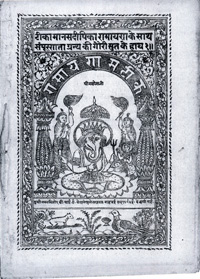India in print
Ulrike Stark discovers a forgotten literary figure from India’s colonial past.
By Brooke E. O’Neill, AM’04
Image courtesy of Ulrike Stark
Call it serendipity. Ulrike Stark had just begun teaching at Heidelberg University in 1995 when a librarian asked her to examine a box of old Hindi and Urdu pamphlets and books stashed in the school’s South Asia Institute. Brittle to the point of disintegration, they were earmarked for the trash bin. Stark, meanwhile, had been searching for a postdoctoral project. A researcher of modern Hindi literature, whose dissertation at Germany’s University of Bamberg explored Hindi novels by Muslim authors, she wanted to move beyond pure literary analysis. Leafing through the texts—mostly small, unbound papers—she found her subject. “I realized the kind of treasure we had lying about, tucked away in the stacks of our library,” says Stark, who immediately had them moved to her office.
 Kishore published many religious texts, like this 1894 edition of Ramcaritmanas.
Kishore published many religious texts, like this 1894 edition of Ramcaritmanas.
She was more right than she knew. The documents turned out to be from the Naval Kishore Press, the largest Indian-owned publishing house in South Asia during the 19th century. Its founder, small-time printer and journalist Naval Kishore, was catapulted into the limelight when the British Crown seized India in 1857 and named him an official provincial printer a year later. Based in the thriving north metropolis of Lucknow, he quickly secured a monopoly in textbook printing, allowing him to finance scores of less lucrative projects, such as translating rare religious texts and preserving endangered manuscripts. Over the next 37 years Kishore published more than 5,000 titles, including religious, scientific, and literary works in Hindi, Sanskrit, Arabic, Persian, and Urdu.
In An Empire of Books: The Naval Kishore Press and the Diffusion of the Printed Word in Colonial India, 1858–1895 (Permanent Black, 2007), Stark examines how Kishore combined the roles of entrepreneur and cultural patron. For early printer-publishers such as Kishore, book production “was very much a vocation, much more than a business,” says Stark, a professor in South Asian languages and civilizations whose interest in India began during a six-month trip between high school and college. Even as Kishore’s publishing house became a popular gathering place for writers, artists, and intellectuals, he ensured that “knowledge was no longer the preserve of the elite.” Producing and distributing low-cost editions of religious works and other classics in several regional languages, he made books accessible to a diverse lay readership composed largely of India’s growing middle class. Among the press’s offerings: the first illustrated, abridged, pocket version of the popular Hindu epic Ramcaritmanas.
A Hindu himself, Kishore also introduced the Qur’an into thousands of Muslim households in India and beyond. With Lucknow as his backdrop—by the early 19th century the city had evolved into the “foremost seat of Islamic learning in North India”—he produced 17 editions of the holy text, including an oversized calligraphy version for children and, as the original text states, “those of weak eyesight.” He also exported editions to the rest of the Islamic world, selling to foreign traders from the Middle East and Central Asia. In 1871 alone, the press sold roughly 20,000 copies of the Qur’an.
By the time Stark stumbled upon the Kishore publications in Heidelberg, the press’s legacy had been largely forgotten. Still an emerging field, she says, Indian book history suffers from a “paucity of basic empirical data on just about every aspect of production and consumption.” Knowledge of book-trade infrastructure, reading practices, and even literacy rates during the early colonial years remain murky. Even if rough estimates of 5 to 6 percent literacy among northwestern India’s Hindu and Muslim communities are correct, says Stark, they don’t provide an accurate gauge of print-culture consumption. A tradition of communal reading would still have allowed illiterates to engage with books.
Poor preservation practices also impede research into early Indian publishing. “I was working without the very documents that the book relies on: publishers’ correspondence, archives, ledgers,” says Stark. In the late 1990s she made three trips to Lucknow and met with some of Kishore’s descendents—the family still ran a small book depot—hoping to access the publisher’s archives. Alas, “whatever they had left was in rotten condition,” she says, pulling out a brittle page she retrieved from an 1894 Ramcaritmanas. Given India’s sweltering climate, the use of cheap industrial paper, and pests such as termites, little from the original publishing house had survived.
Fortunately, British-colonial archives helped fill in some gaps. By meticulously categorizing and recording publications, the government hoped to better understand the country it had colonized. Nothing published after the 1860s seems to have gone unregistered, says Stark. “In ruling India, the British went by the notion that knowledge is power.”
Kishore and other colonial-era Indian thinkers shared that view. Among them was public intellectual Raja Shivaprasad, whose biography Stark is working on: In Times of Transition: Raja Shivaprasad ‘Sitara-e Hind.’ The first Indian to hold the post of inspector of schools in the provinces, he fought for mass primary education and championed modern scientific methods, enduring scorn for his loyalty to the British.
Like her investigation of Kishore, Stark’s study of Shivaprasad marks one of the first in-depth explorations of a prominent north Indian thinker navigating early colonial rule. “Except for the case of some iconic figures,” she says, “we know little about the ways in which intellectuals in this part of India lived their lives as colonial subjects, interacted with one another, and engaged with Western knowledge.” By retracing their steps, she hopes to fill the void.
